Some of the sun’s iconic coronal loops may be illusions
Coronal loops, well-defined hot strands of plasma that arch out into the sun’s atmosphere, are iconic to the sun’s imagery. But many of the supposed coronal loops we see might not be there at all.
Some coronal loops might be an illusion created by “wrinkles” of greater density in a curtain of plasma dubbed the coronal veil, researchers propose March 2 in Astrophysical Journal. If true, the finding, sparked by unexpected plasma structures seen in computer simulations of the sun’s atmosphere, may change how scientists go about measuring some properties of our star.
“It’s kind of inspiring to see these detailed structures,” says Markus Aschwanden, an astrophysicist at Lockheed Martin’s Solar & Astrophysics Lab in Palo Alto, Calif., who was not involved in the study. “They are so different than what we anticipated.”
Sign Up For the Latest from Science News
Headlines and summaries of the latest Science News articles, delivered to your inbox
Thank you for signing up!
There was a problem signing you up.
Scientists have begun to develop a better understanding of the sun’s complex atmosphere, or corona, only in the last few years (SN: 12/19/17). Coronal loops have been used to measure many properties of the corona, including temperature and density, and they may be key to figuring out why the sun’s atmosphere is so much hotter than its surface (SN: 8/20/17). But astronomers have long wondered just how the loops appear to be so orderly when they originate in the sun’s turbulent surface (SN: 8/17/17).
So solar physicist Anna Malanushenko and her colleagues attempted to isolate individual coronal loops in 3-D computer simulations originally developed to simulate the life cycle of a solar flare. The team expected to see neatly oriented strands of plasma, because coronal loops appear to align themselves to the sun’s magnetic field, like metal shavings around a bar magnet.
Instead, the plasma appeared as a curtainlike structure winding out from the sun’s surface that folded in on itself like a wrinkled sheet. In the simulation, many of the supposed coronal loops turned out to not be real objects. While there were structures along the magnetic fields, they were neither thin nor compact as expected. They more closely resembled clouds of smoke. As the team changed the point of view from which they looked at these wrinkles in the veil in the simulation, their shape and orientation changed. And from certain viewing angles, the wrinkles resembled coronal loops.
The observations were mind-blowing, says Malanushenko, of the National Center for Atmospheric Research in Boulder, Colo. “The traditional thought was that if we see this arching coronal loop that there is a garden hose–like strand of plasma.” The structure in the simulation was much more complex and displayed complicated boundaries and a raggedy structure.
Still, not all coronal loops are necessarily illusions within a coronal veil. “We don’t know which ones are real and which ones are not,” Malanushenko says. “And we absolutely need to be able to tell to study the solar atmosphere.”
It’s also not clear how the purported coronal veil might impact previous analyses of the solar atmosphere. “On one hand, this is depressing,” Malanushenko says of the way the new findings cast doubt on previous understandings. On the other hand, she finds the uncertainty exciting. Astronomers will need to develop a way to observe the veil and confirm its existence. “Whenever we develop new methods, we open the door for new knowledge.” More



